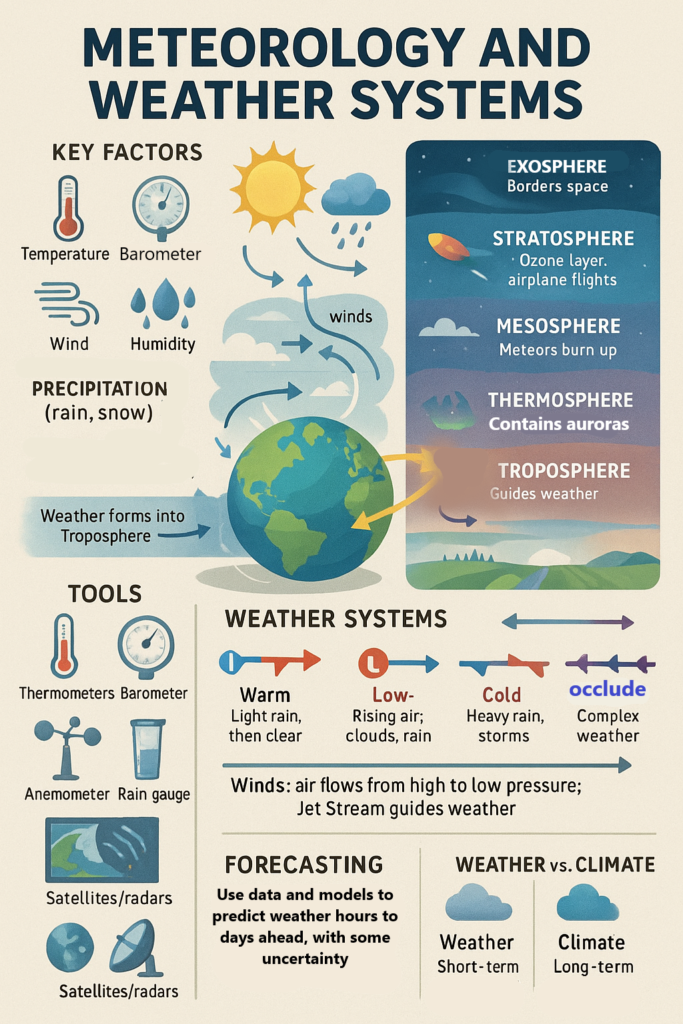Meteorology and Weather Systems
What is Meteorology?
Meteorology is the science that studies the atmosphere, especially the weather. It helps us understand why it rains, how storms form, or why some days are sunny while others are cloudy. Meteorologists are the scientists who observe, study, and predict the weather.

What Meteorologists Study:
- Temperature (how hot or cold it is)
- Air pressure (the weight of air above us)
- Wind (air moving from high to low pressure)
- Humidity (amount of moisture in the air)
- Clouds and precipitation (rain, snow, hail, etc.)
Meteorology is important because it helps us plan our daily lives, stay safe during storms, and even helps farmers, pilots, and sailors.
Layers of the Atmosphere and Their Role
The atmosphere is the layer of gases surrounding Earth. Weather happens in the lowest layer, called the troposphere.
Main Layers of the Atmosphere:
- Troposphere – Where all weather occurs; closest to the Earth.
- Stratosphere – Contains the ozone layer; airplanes often fly here.
- Mesosphere – Where meteors burn up.
- Thermosphere – Where auroras (northern lights) happen.
- Exosphere – Outermost layer; where space begins.
In the troposphere, the sun heats the Earth’s surface, which warms the air above it. Warm air rises and cool air sinks, creating winds, clouds, and storms.
Weather Systems – How Weather Works
A weather system is a pattern of weather created by the movement of air and moisture in the atmosphere. Let’s look at the most common ones:
1. High-Pressure System (H):
- Air sinks and spreads out.
- Brings clear skies and calm weather.
- Often called “fair weather systems.”
2. Low-Pressure System (L):
- Air rises and forms clouds.
- Brings rain, clouds, and sometimes storms.
- Associated with unsettled weather.
3. Fronts:
These are the boundaries between different air masses (warm and cold).
- Warm Front: Warm air slides over cold air – brings light rain and then clear skies.
- Cold Front: Cold air pushes under warm air – can bring heavy rain or thunderstorms.
- Stationary Front: Neither air mass moves – causes days of clouds or rain.
- Occluded Front: A cold front overtakes a warm front – leads to complex weather patterns.
4. Wind Systems:
Winds are created when air moves from high to low pressure. Large wind patterns, like the Jet Stream, influence the movement of weather systems across continents.
Tools, Forecasting, and Climate vs Weather
Tools Meteorologists Use:
- Thermometers – measure temperature
- Barometers – measure air pressure
- Anemometers – measure wind speed
- Rain gauges – measure rainfall
- Weather satellites and radars – track clouds, rain, and storms from space
Weather Forecasting:
Using computer models and data from all over the world, meteorologists can predict the weather from a few hours to a week in advance. Forecasts aren’t always perfect, but they’re usually pretty close!
Weather vs Climate:
- Weather is the condition of the atmosphere right now or over a short time (days/weeks).
- Example: “It’s raining today.”
- Climate is the average weather of a place over a long period (30+ years).
- Example: “This region has a tropical climate.”
Understanding both helps us prepare for daily life and long-term changes like global warming.
Summary:
Meteorology is the science of studying and predicting the weather by observing the atmosphere. Weather systems like high and low pressure, and air masses, create patterns like sunshine, rain, and storms. Tools like radars, satellites, and thermometers help meteorologists forecast weather. Weather tells us what’s happening now, while climate tells us what usually happens over time. By learning about meteorology, we can better understand our environment and stay prepared for any kind of weather.
Tags: air pressure, anemometers, atmosphere, atmospheric layers, atmospheric science, auroras, barometers, climate, climate change, climate vs weather, clouds, cold front, environmental science, Environmental Studies, exosphere, forecasting models, Global Warming, high-pressure system, humidity, jet stream, low-pressure system, mesosphere, meteorologists, Meteorology, northern lights, occluded front, precipitation, rain gauges, stationary front, storm tracking, stratosphere, temperature, Thermometers, thermosphere, troposphere, warm front, weather, weather conditions, weather data, weather forecasting, weather forecasting accuracy, weather fronts, weather observation, weather patterns, weather phenomena, weather prediction, weather radars, weather satellites, weather stations, weather systems, weather tools, wind


